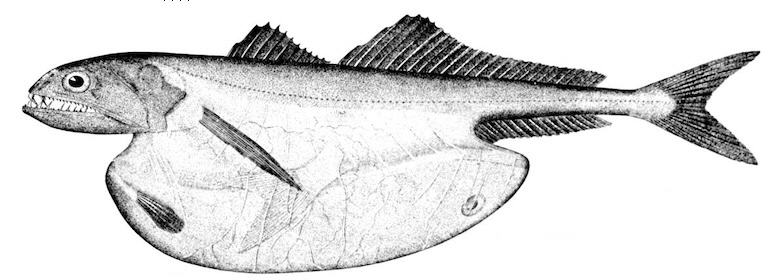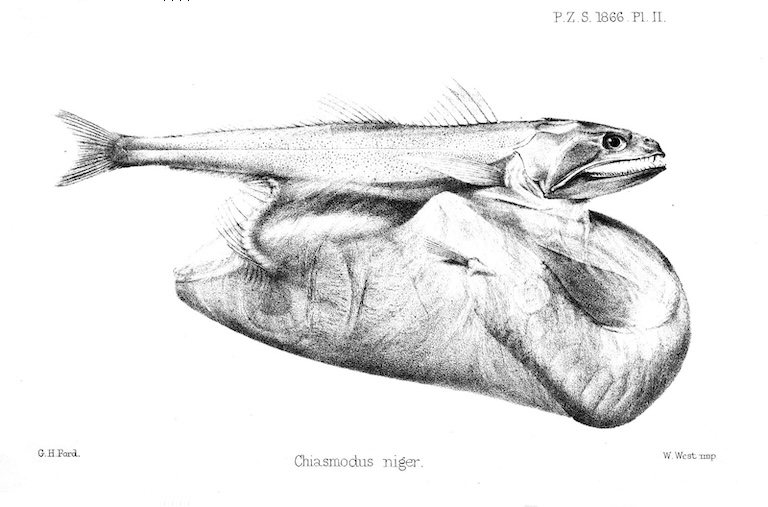Black Swallower Profile
It used to be that zoologists could hide their lack of imagination by naming things in Latin or Greek. That’s how the “Nose horn” became a rhinoceros and the “River horse” became a hippopotamus.
But new animals are being discovered all the time, and the budget cuts meant that curricula in all but the most expensive schools ditched the classics decades ago, in favour of more useful languages, like text speak.
So now we have the black swallower: a product of the tragic decline in Western education.

Black Swallower Facts Overview
| Habitat: | Deepwater, marine |
| Location: | Widespread, primarily in the Atlantic Ocean |
| Lifespan: | Unknown |
| Size: | Up to 25 cm (9.8 in) long |
| Weight: | |
| Colour: | Brownish-black |
| Diet: | Bony fish and cephalopods |
| Predators: | Bony fish and cephalopods, also sharks |
| Top Speed: | Unknown, slow |
| No. of Species: | 1 |
| Conservation Status: | Not Listed |
The black swallower is a curious example of how being really, really good at something can sometimes kill you.
But it lives so far down in the water it’s not easy to ever find one alive, at least in its mature state, so understanding anything about it has to come primarily from dead examples.
Still, what we do know is as weird as it is expected from such a dark and isolated ecosystem.
Interesting Black Swallower Facts
The black swallower is a curious example of how being really, really good at something can sometimes kill you. But it lives so far down in the water it’s not easy to ever find one alive, at least in its mature state, so understanding anything about it has to come primarily from dead examples.
Still, what we do know is as weird as it is expected from such a dark and isolated ecosystem.
Black Swallower Facts
1.They’re Scombriformes
As we all should know by now, There’s no such thing as a fish. You’d think that this small detail creates a lot of trouble for people emotionally invested in fish taxonomy, but they’ve done remarkably well considering the handicap.
The black swallower once thought to be a member of the Perciformes order with the surgeonfish and sergeant-majors, has now been moved to the Scombriformes order, to live with the more simply-named bluefishes and hairtails.
They remain in their family, Chiasmodontidae, which are fishes collectively known as snaketooth or swallower fish, and members are found in every ocean worldwide.
As the nicknames suggest, they’re characterised by having large mouths and lots of scary teeth, and the black swallower disappoints nobody in these regards.
There are seven other members in its genus, but this is the most well-documented, being the most widespread of all of them. 1
2. They’ve got weird teeth
There are several features that set this fish apart from its congeners, including various pores in its skull, rays in its pectoral fins and other boring things that only fish nerds are looking for.
But one obvious and more interesting difference is in its mouth. Its teeth are almost entirely straight, and their alignment is unique to this species.
More curiously, the teeth aren’t fixed in place but move about in their sockets, which presumably helps in feeding, though perhaps more by simply getting out of the way. 2
3. They have a big gulp
It’s not uncommon for deepsea fishes to have large stomachs. Food isn’t easy to come by, so limiting yourself to the occasional tiny morsel is a tremendous handicap and it is useful to be able to take the biggest bite you can, not knowing when the next one will come alone.
Gulper eels are perhaps the best-known animals to use this strategy, but the black swallower does perhaps outclass even this iconic monster.
Black swallowers have flexible everything, including the teeth we just mentioned and a gut that isn’t belted by conjoined pelvic fins, and thus can expand unhindered like a Bavarian in October.
The mouth, too, is necessarily bendy, similar to that of a snake’s, and serves to engulf prey not only smaller than the swallower but in some instances even longer or heavier than it is.
Like the neck of a pelican, the stomach of this fish keeps its prey contained until digestion can do its job. Unfortunately, sometimes this happens too slowly. 3
4. They mess up sometimes
Darwinian evolution necessitates not the perfect, but merely the marginally least crap designs, and this is evident in the countless natural malfunctions we see in nature.
Stick a live mammoth in some tar and you’ll get six hungry sabre-toothed cats getting stuck along with them; give a human unfettered access to refined sugar and it’ll eat so much it needs to be lifted by crane to the zoo for an MRI.
Likewise, the black swallower sometimes bites off more than it can chew, and the majority of what we know about them comes from times when this has happened.
When swallowing something, it’s important that digestion occurs faster than decomposition. We don’t worry about meat going rancid after we eat it because it’ll be destroyed and absorbed long before that has a chance to happen.
Not so with the swallowers. Sometimes, the prey is so huge that it starts to rot before the fish’s digestion has had a chance to finish the job, and when this happens, it gets gassy.
Gas build-up, while the source of endless humour in humans, is fatal for deep sea fish, who rapidly float to the surface and are killed. Some of the largest museum specimens of this species were discovered this way, at least one with an animal ten times the swallower’s mass inside it.
But this species is known to make deliberate vertical migrations, at least once.

5. They descend as they age
The international fishing industry is the most comprehensive marine sampling system the world has. It spans every ocean and almost every depth and brings up more or less every animal there is to find, give or take the Cthulus and leviathans that have so far successfully evaded us.
Of course, once up, they’re all dead, and the industry does little to solve this or pay reparations, but this overwhelmingly net-negative effect does not discount the slither of benefit we get from finding what’s there in the first place.
It is this system that has given marine biologists clues to the lifecycle of some of the deepest-living animals, and the black swallower is one of them. The majority of adults appear to live below the photic zone, down to around 4,000 metres but can be found as close to the surface as around 400m.
Interestingly, though, juveniles of this species are found much higher in the water column, from near the surface to about 800 metres.
Eggs, too, are found in the coastal shallows, seasonally, and around South Africa in particular. This might be a clever strategy since there’s more food to swallow up there, and it’s likely that competition increases, the larger the fish gets, so it’s perhaps prudent to move back down into the inky blackness as it ages. 4
Black Swallower Fact-File Summary
Scientific Classification
| Kingdom: | Animalia |
| Phylum: | Chordata |
| Class: | Actinopterygii |
| Order: | Scombriformes |
| Family: | Chiasmodontidae |
| Genus: | Chiasmodon |
| Species: | niger |
Fact Sources & References
- A. M. Prokofiev (2009), “Systematics and distribution of black swallowers of the genus Chiasmodon (Perciformes: Chiasmodontidae)”, Springer Nature Link.
- “Chiasmodon niger Johnson”, Fish Base.
- “This bizarre ‘black swallower’ balloon fish can eat an insane amount of food”, BBC Science Focus.
- Stephanie Boyd, “Black Swallower”.
